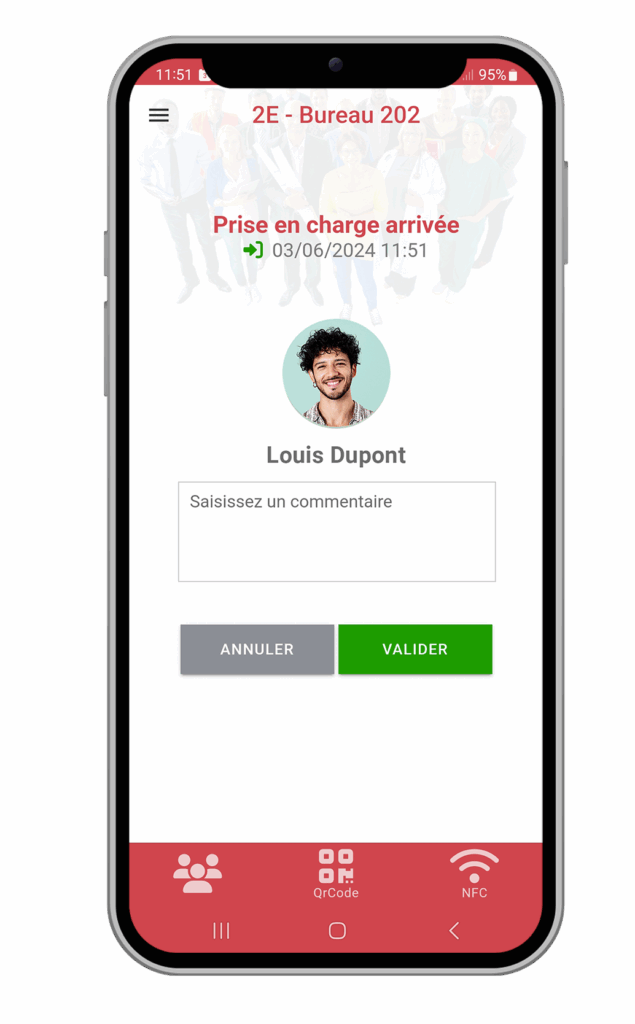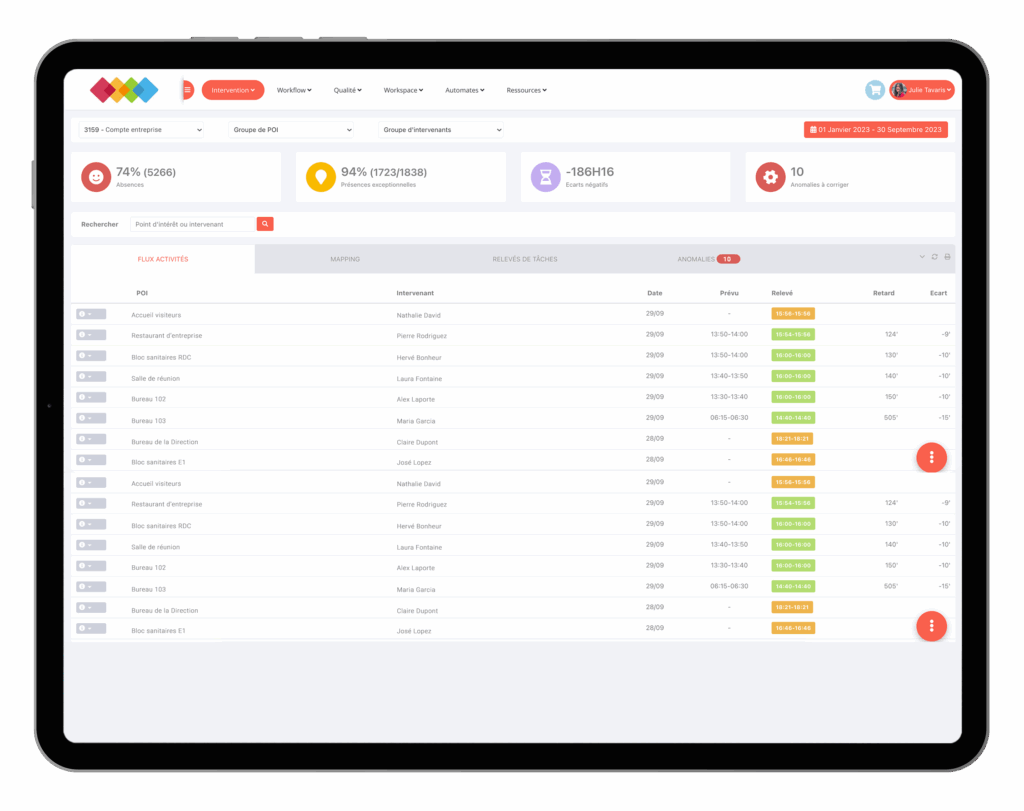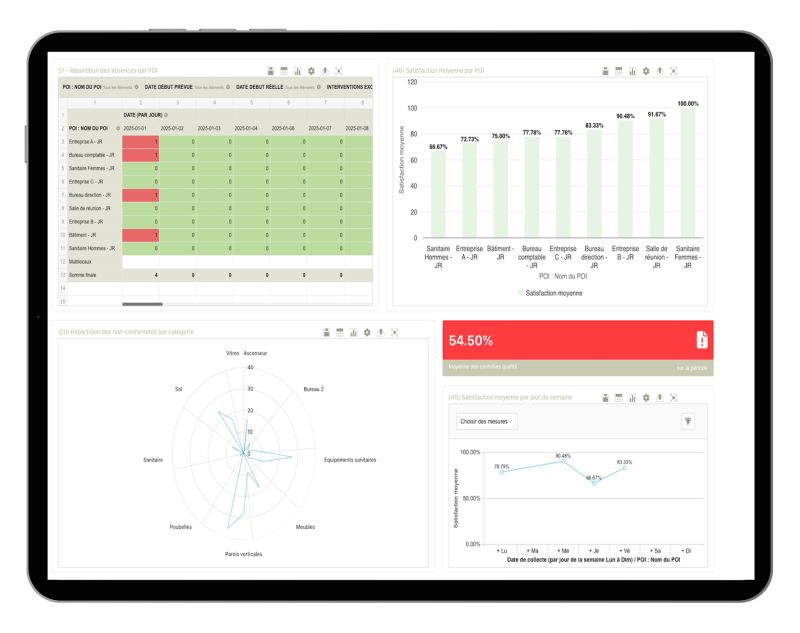An unscheduled employee absence can cost a service provider up to €2,000 per day… Between unworked paid hours, employer contributions, and last-minute replacements, absenteeism is a major financial drain. Each unexpected absence impacts your company’s long-term stability and most importantly, your clients’ satisfaction! To avoid these situations, it’s essential to anticipate the early warning signs. For a long time, attendance time management was seen as a mere administrative formality. But today, it’s evolving into a far more strategic function: capturing daily work patterns and trends. When used effectively, it becomes a powerful tool for preventing absenteeism and promoting long-term employee engagement. Discover how to optimize attendance time management and the best practices to adopt.

Why is absenteeism skyrocketing in the service sector?
For several years, the cleaning sector has been experiencing a rise in absenteeism among its workforce. In 2023, the absenteeism rate in service activities reached 6.73 percent, representing an average of 24.6 days of absence per employee per year (Absenteeism and Engagement Barometer 2024).
Several factors contribute to this issue:
- Challenging working conditions : such as irregular hours, physically demanding tasks, split shifts, or assignments in isolated environments. These constraints affect both the physical and mental health of staff.
- Persistent job insecurity and lack of recognition : Involuntary part-time contracts, low appreciation for the profession, and limited career advancement opportunities all weaken employee engagement.
The lack of structured monitoring of attendance time: without the right tools, it becomes difficult to identify signs of distress, burnout, an unsuitable workload, or the risk of disengagement.
The result is that absences multiply, disrupting organization, weakening service continuity, and ultimately affecting the quality of service provided to the client. Your company’s performance depends on the stability of its teams. If they are frequently absent, your long-term viability suffers. Therefore, rethinking and optimizing attendance time management is one of the effective ways to ensure your employees want to come to work with you every morning.
What are the impacts of absenteeism on your company?
Beyond the financial aspect, poor attendance time management can lead to a real organizational disaster. Every unplanned absence disrupts schedules, increases individual workloads, and sometimes assigns unqualified people to tasks that are vital for your clients. When an employee does not show up in the morning, the entire day’s rounds have to be reconsidered. And it is not just a matter of scheduling,

Behind the scenes, you have to juggle all the associated HR factors: hours already worked, overtime premiums, specific terms of the employee’s contract, compatibility with the job description… Now imagine when it’s not just one employee absent but several.
- Loss of revenue: Poor attendance time management inevitably impacts payroll and compensation. Several scenarios can occur: either you pay employees who have not actually worked, or you underpay employees based on the work performed. In both cases, you lose money through contractual penalties, overbilling, replacement costs, and more.
- Deterioration of working conditions: Poor attendance management often leads to the overexploitation of human resources. Not to mention the pressure it creates on the employees present, who are often forced to cover at the last minute. Over time, this overload fosters employee distress and can lead to complete disengagement. You then enter a vicious circle of absenteeism: employees are absent without warning, so I am overburdened; I cannot keep up with the high pace, so I become absent myself. And so on.
- Decline in client satisfaction: It does not stop there. An unstable workforce weakens your relationship with clients: poorly covered sites, incomplete or non-compliant services can quickly damage your reputation and jeopardize your contracts.
Attendance time management tools
Cleaning, security, reception, hospitality… Whatever the service sector, you cannot afford to disrupt the continuity of operations, even in the event of an unexpected absence. That is where attendance time management tools come into play. Specifically, with these solutions, you have a clear and real-time view of attendance, absences, delays, and deviations from planned schedules.
An asset for anticipating and taking action
Preventing absenteeism in the cleaning sector is not a matter of chance but of a well-structured strategy. But what exactly does this involve? Attendance time management means tracking, analyzing, and optimizing the actual working hours of your employees. You compare planned services with actual presence in the field. You identify discrepancies and reassign resources on intervention routes if needed. You structure contracts according to the realities of the job.
By centralizing this data in digital tools, you detect risks and warning signs earlier such as recurring absences at an operational site, frequent delays on one or more tasks, and increasing sick leaves. These are all indicators that help you with prevention. Moreover, by structuring your schedules and recognizing your employees’ working time, you improve their daily experience and their sense of appreciation.

Attendance time management tools are also a way to recognize work. For a cleaning staff member starting their rounds at dawn or a technician called in urgently in the middle of the night, knowing that their hours are accurately recorded is a strong sign of trust. On one hand, they know their work will be fairly compensated. On the other hand, they are aware that their daily commitment is visible, acknowledged, and valued by contractors or end clients.
Finally, no more social conflicts, heated disputes, or resignations without a word. When overtime or additional hours are properly accounted for, employees are satisfied. In this way, attendance time management becomes a tool to reduce absenteeism and improve employee retention.
Attendance time management tools
Apps, software, connected devices, IoT sensors… Attendance time management can be handled using a wide range of tools. Gone are the days of paper-based methods; technology is now everywhere in Facility Management. Are you still relying on manual processes? Beware, competition is fierce in this field, and falling behind could become a real disadvantage for your company’s growth.
There are several tools available to record clock-ins and then digitalize attendance time management:
- Mobile clock-in apps
- Time clocks (NFC, code-based, infrared, etc.)
- QR codes
- IoT sensors
- Connected terminals
- Scheduling software
- Industry-specific software such as ERP and HRIS
- HR portals
- Analytics and reporting platforms
Discover our tips for choosing a clock-in app
What are the best practices to improve attendance time management?
Implementing effective attendance time management is an essential step to sustainably address your absenteeism issues. To gain all possible benefits, certain best practices are necessary:
Map out your processes and digitalize them
Forget Excel spreadsheets and paper attendance sheets. To improve attendance time management and, above all, boost the reliability of your operational data, it is time to implement the right digital tools. But you cannot dive in headfirst unless you are ready to see your chances of success go up in smoke.
The first step is to analyze, document, detail, and map out your company’s time tracking processes. Where do your employees clock in? How do they do it? Who collects the information and working hours? Who inputs them into the payroll system? All of these elements should be gathered into a summary document that will serve as a foundation for deploying effective attendance time management tools.
Once your organization is clearly structured, it becomes much easier to find the right fit. By comparing your user profiles and the needs of your different roles with the features offered, you can be confident in choosing a relevant attendance time management solution. But do not overlook the technical and budgetary aspects. Acquisition costs, additional fees, and included services should also be carefully analyzed before making your decision.

Involve managers and teams
Effective attendance time management also relies on consistent involvement across all levels of the hierarchy. Leadership, managers, clients, and frontline staff must all be on the same page. To achieve this, you will need to activate several engagement levers. A tool that is used is first and foremost a tool that is understood by its users. Train your supervisors on how to use the tools, provide them with the right indicators to make quick decisions, and most importantly, raise awareness among your teams about the importance of their commitment. This creates a collective dynamic. The more your employees feel responsible, the more they commit to attendance goals. This participative approach fosters a company culture focused on reliability and service excellence.
Automate absence alerts and reporting
How can you act quickly to arrange a replacement if you receive an absence notification three hours later? How can you instantly detect real absences when you receive 150 emails a day? You cannot. To respond quickly to an absence or a discrepancy, you absolutely need an automated reporting system. Alerts in case of anomalies, preconfigured action plans, automatic triggers, customized dashboards advanced attendance time management tools allow you to act in real time and adjust schedules without delay. Real time updates of your reports let you track on site presence instantly and ensure your contractual commitments are met.
By centralizing all attendance data in a single environment, you gain clarity. Risk areas are quickly identified, you have a clear view of where your teams are, and you can reallocate resources in just a few clicks.
MoveWORK solutions for smart attendance time management!
To prevent absenteeism, anticipation is your number one asset.
How can you achieve this? By detecting absenteeism trends.
Are your employees often absent on Mondays? Is the absenteeism rate higher in a particular team? Do you notice frequent but short absences? Answer all these questions with MoveWORK solutions! Designed for your employees, your supervisors, you, and your clients, our tailor-made tools offer you intelligent and proactive attendance time management.
The myMissions mobile app for your employees
The myMissions app simplifies your employees’ daily work and quickly becomes their favorite connected assistant! With this mobile app, each employee can clock in and out, view their tasks in real time, report an absence or delay, and declare an incident.
The myMissions app allows you to:
- Defend yourself in case of disputes with a dated history of all completed interventions
- Provide photo evidence in case of incidents to prove non-involvement
- Easily access a document database to follow protocols when in doubt
- Develop employee autonomy through task and workload management
- Request help or reinforcements if the employee cannot resolve a problem alone
How to get your employees to accept clocking in?
The MoveWORK Flow platform for attendance time tracking
At the same time, the MoveWORK Flow platform allows you to centralize and manage all data related to your teams’ attendance times. Once collected via myMissions, the information is uploaded to the platform and displayed in easy-to-read charts.
An employee is absent? No worries. MoveWORK Flow flags the absence on the platform, and you are instantly notified so you can start the replacement process right away.

Then, to analyze absenteeism trends, thanks to its library of ready-to-use dashboards and automated reports, MoveWORK Flow allows you to easily track absences, hours worked, and deviations from schedules. You identify trends, anticipate issues, and gain full visibility into absenteeism risks. This enables you to adjust your resources in real time and ensure the continuity and quality of your services.

